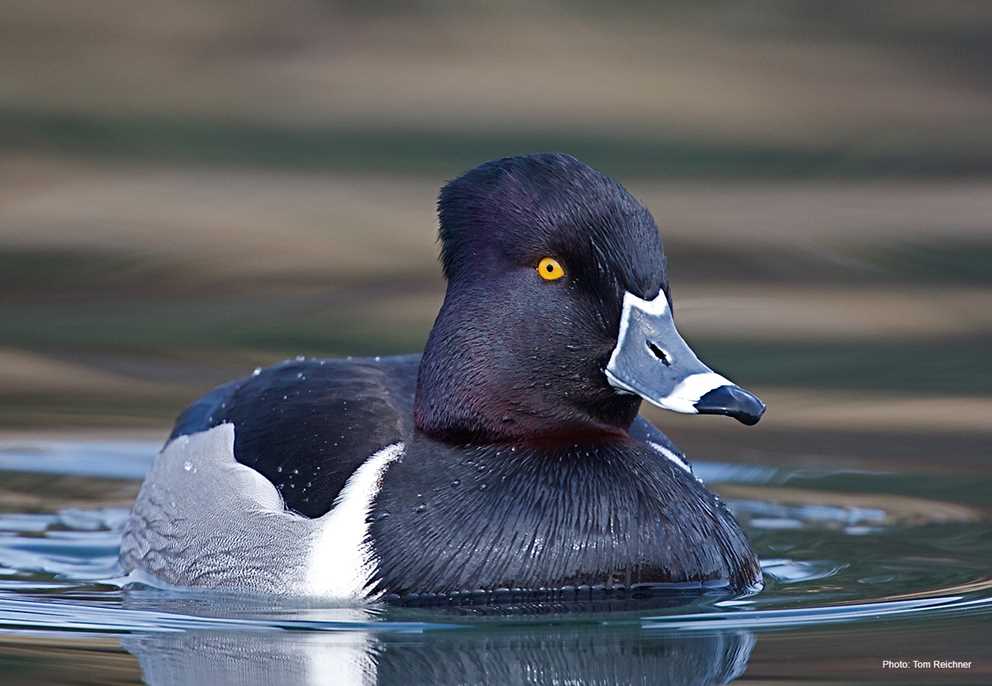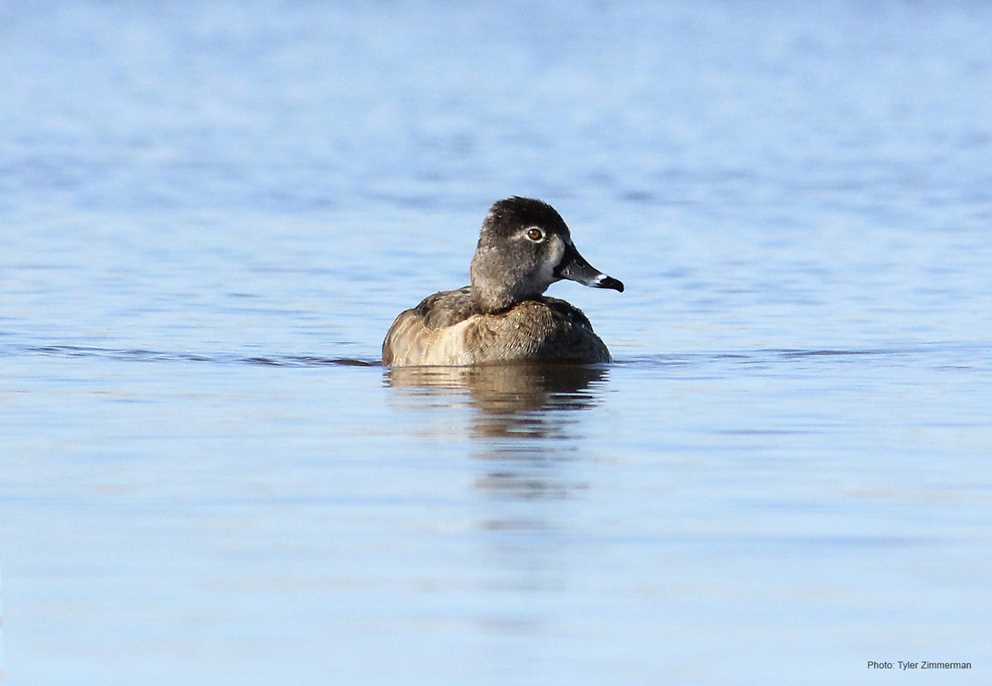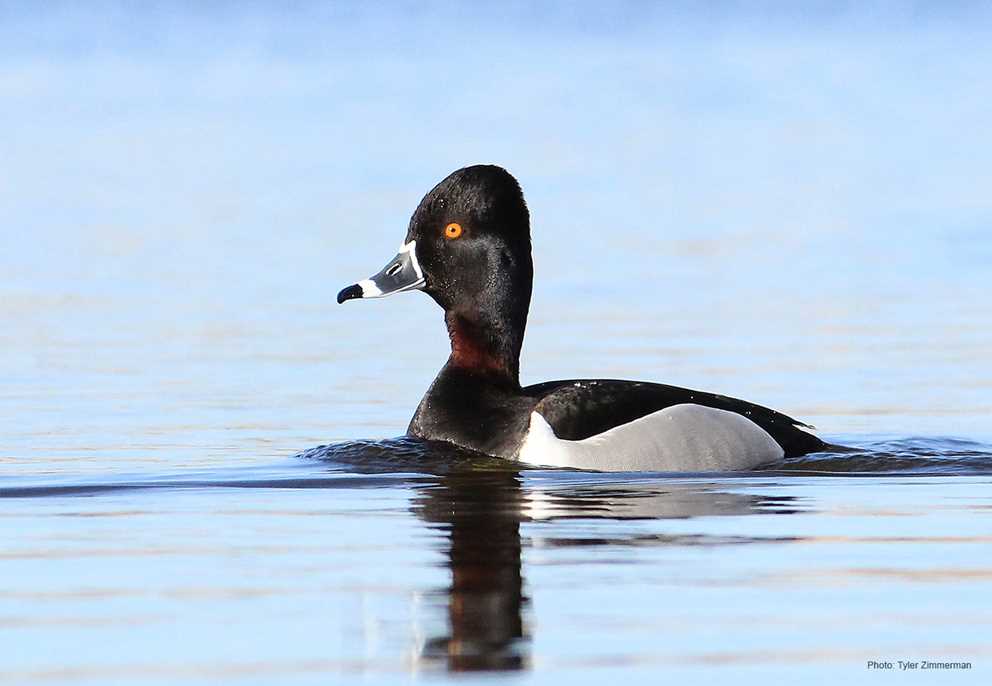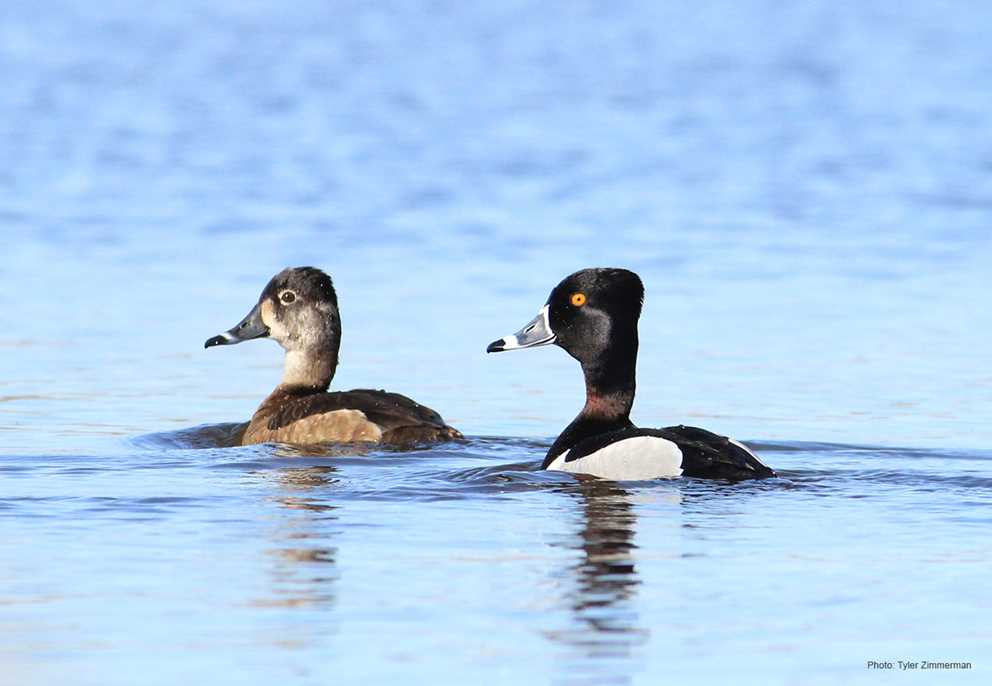Overview
The Ring-necked Duck is a small to medium-sized diving duck found only in North America. Males are known for their dark purplish-black heads, which may show iridescence in good light, and their bluish-gray bills with a white band near the tip and dark gray or black tip. They have a black breast, back, and rump, which contrast with white flanks. A distinctive white crescent forms a sharp triangle on the side between the breast and back. Though the species is named for a cinnamon-colored neck ring, it is rarely visible except in optimal light. Females have brownish-gray bodies, buffy-brown heads, and white belly feathers. In flight, males exhibit contrasting black and white plumage, while females appear drab brown with brown-gray upper wings and gray speculums.
They breed in boreal forest wetlands across Canada, central Alaska, and parts of the Prairie Pothole Region and Intermountain West. Migration and winter habitats include freshwater lakes, rivers, and marshes, with some birds wintering as far south as Central Mexico.
Description
Key Identification Features:
- Ring-necked Ducks fly with fast flight with “choppy” wing strokes in loose flocks.
- Males display black heads, breasts, and backs with white flanks and a white belly.
- Females are drab brown with white bellies and grayish-brown upper wings. On water, males show a sharp white crescent forming a triangle between the breast and side.
Male/Female Average Length and Weight
- Mass: Males 1.5–1.9 lbs.; Females 1.4–1.6 lbs.
- Wing Length: Males 8.1 in.; Females 7.7 in.
Male Identification:
- Alternate (Breeding) Plumage: Males have a purplish-black, peaked head with a black breast, back, and rump. A white crescent separates the dark breast and sides. In good light, a cinnamon neck collar may be visible. The bluish-gray bill has a white band at the base and a black tip, with a yellow-gold iris. The flanks are white with fine silvery vermiculation. In flight, males display bold black and white contrasts, with gray-black wings and a gray speculum.
- Basic Plumage: Dull brownish gray with a dark gray bill and light band.
Female Identification:
- Females have brown-gray bodies, buffy-brown heads, and white belly feathers. Some females may show a faint whitish crescent at the base of the bluish-gray bill, which has a light saddle and dark tip. The iris is brown.
In-Flight Identification:
- Male: Displays strong black and white contrast, with black backs and gray speculums.
- Female: Appears uniformly brown with gray speculums and a lighter head.
Vocalizations:
- Male Calls: Males emit a low whistle when reuniting with mates during nesting.
- Female Calls: Females give a soft purring growl when alarmed or taking flight.
Similar Species:
- Scaups: Ring-necked Ducks may be confused with scaup, but male Ring-necked Ducks have a black back, a white band at the base of the bill, and a gray speculum, compared to the white speculum on both scaup species.
- Female Redheads: Female Ring-necked Ducks are smaller, drab brown with more contrast between their backs and flanks, and have a peaked head shape not found in female Redheads.
Habitat Preferences
Key Habitat Types:
- Breeding: Found in boreal forest wetlands, including bogs, across Canada, Alaska, and parts of the Prairie Pothole Region.
- Migration and Wintering: Use freshwater lakes, rivers, and marshes, occasionally brackish marshes with submerged vegetation like wigeon grass.
Foraging Habits and Diet
- Breeding Season: Breeding females consume invertebrates, especially aquatic insect larvae.
- Migration and Winter: Ring-necked Ducks primarily consume plant materials (~80–90%) by diving in shallow water or tipping in water less than 2 feet deep.
Breeding Habits
- Monogamy: Seasonally monogamous, forming new pairs each spring.
- Nest Locations: Females build nests on hummocks, clumps of vegetation, or mats of floating plants in marshes.
- Clutch Size: 6 to 14 eggs averaging 8. The eggs are olive-buff, gray, or brown, measuring 2.3 by 1.6 in. The incubation period is about 25 days.
Migration & Distribution
- Fall Migration: Departs breeding areas in October, arriving in wintering areas by mid-November. Peak winter numbers occur from mid-December to February.
- Spring Migration: Migration begins in February, with birds returning to breeding areas from mid-April to mid-May.
Conservation Status
- IUCN Status: Least Concern
- Population Status: Population estimates in the Eastern Survey Area have ranged between 606,400 and 954,500 since 1998, with a 2024 estimate of 723,100. The total population is around 2 million birds.
- Conservation Concerns: Loss of boreal forest wetlands and decreased availability of submerged vegetation in winter habitats pose challenges.
- Conservation Focus: Conservation actions focus on protecting boreal wetlands and restoring wintering habitats rich in submerged and floating-leafed plants.
Harvest Information
- An average of 392,555 ring-necked ducks were harvested across the US during the 2019 to 2022 hunting seasons.
- Ring-necked duck harvest is typically highest in the Mississippi Flyway, accounting for around 40 percent of the total US harvest.
- The top three total harvest states for ring-necked ducks across the 2019 to 2022 hunting seasons were Minnesota (230,096), Texas (217,196), and Florida (164,112).





